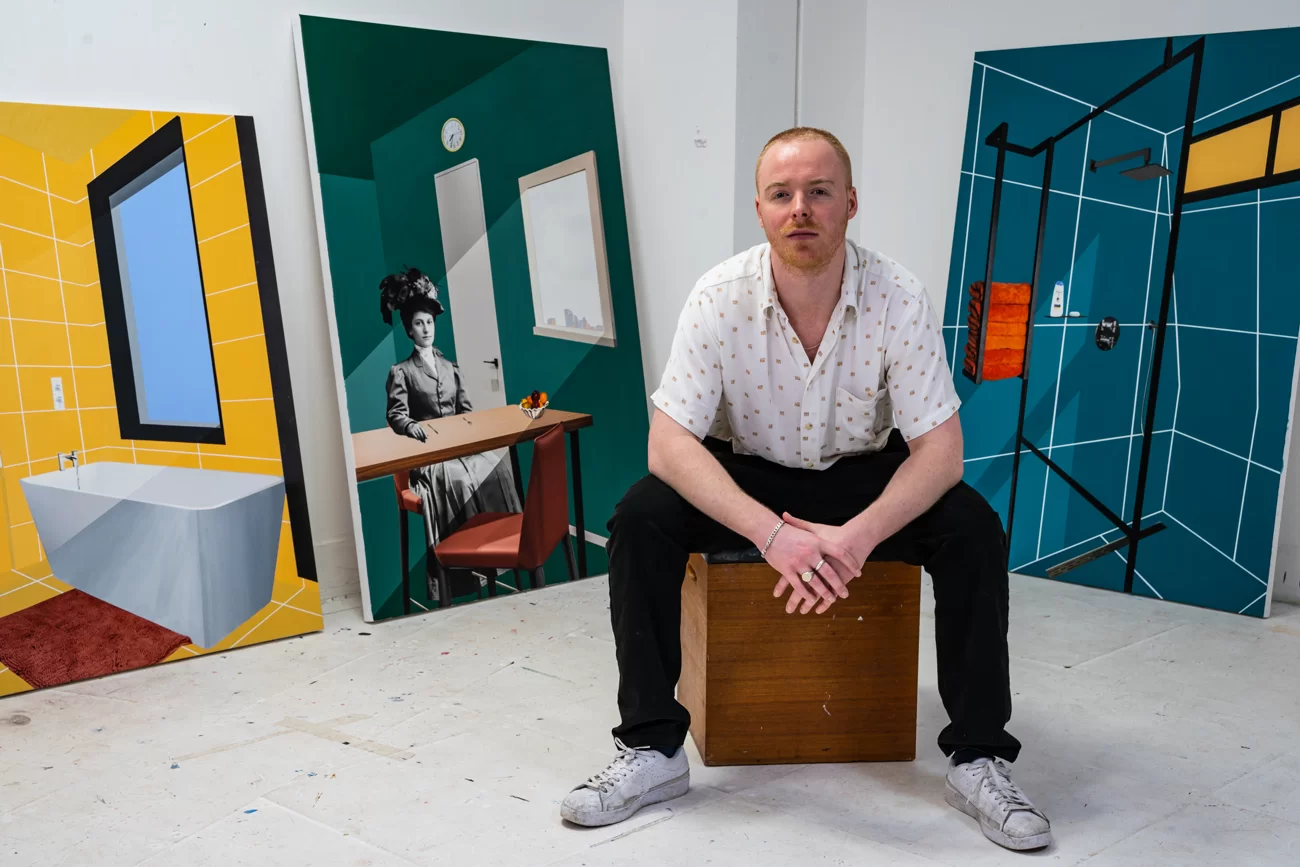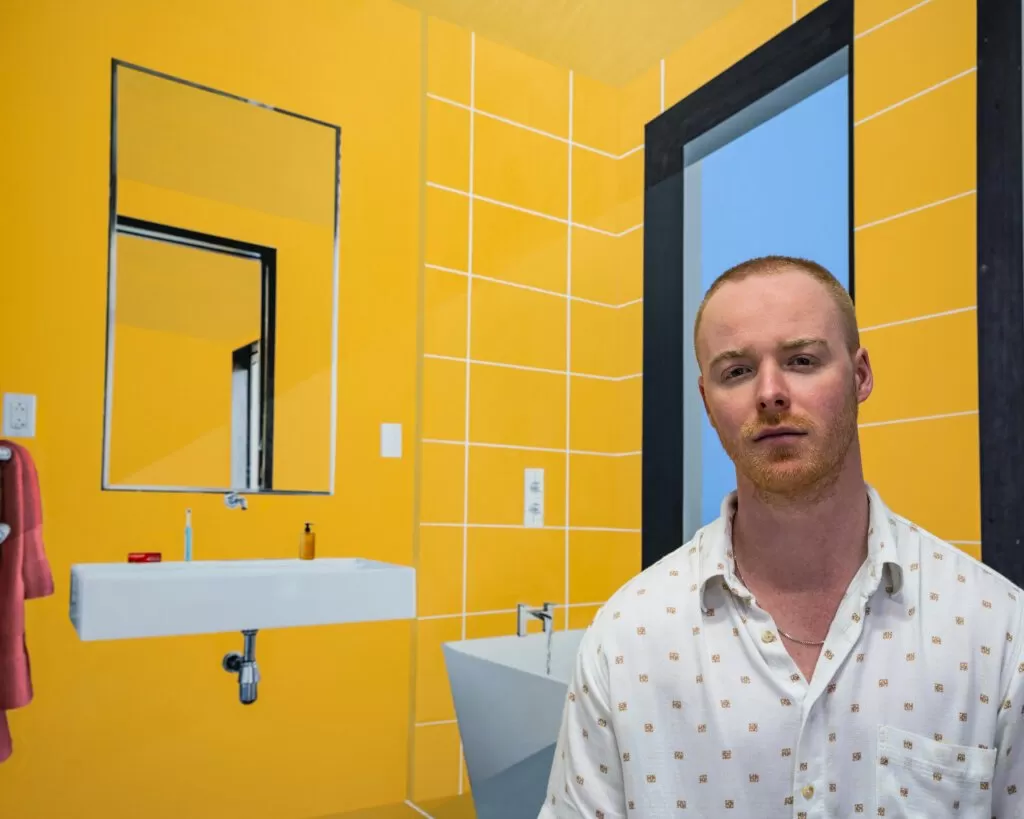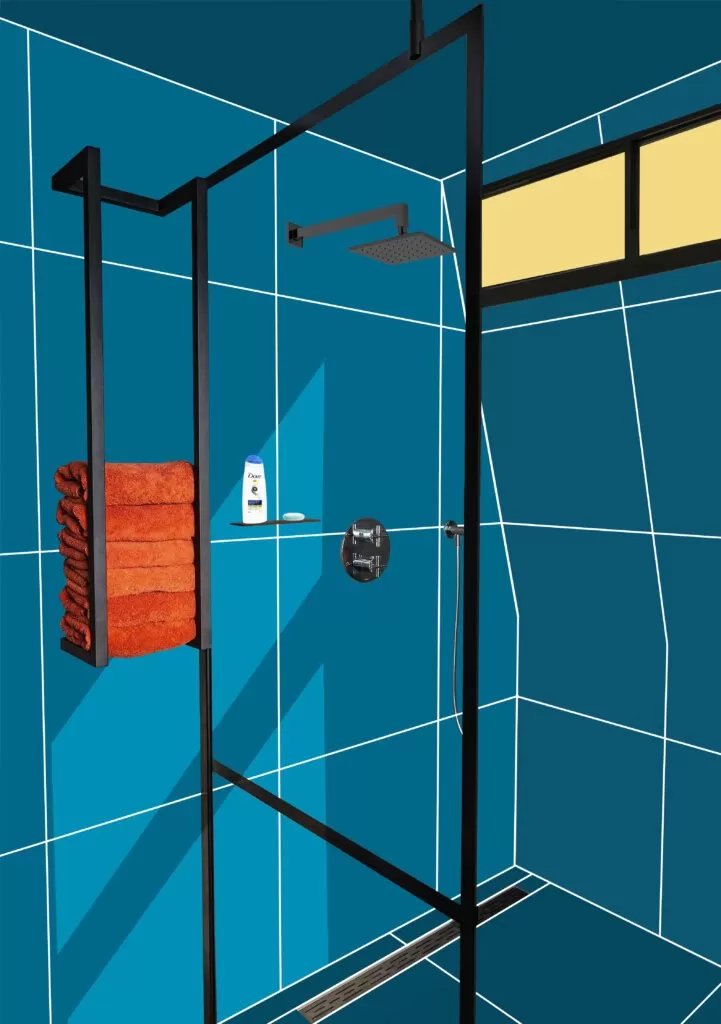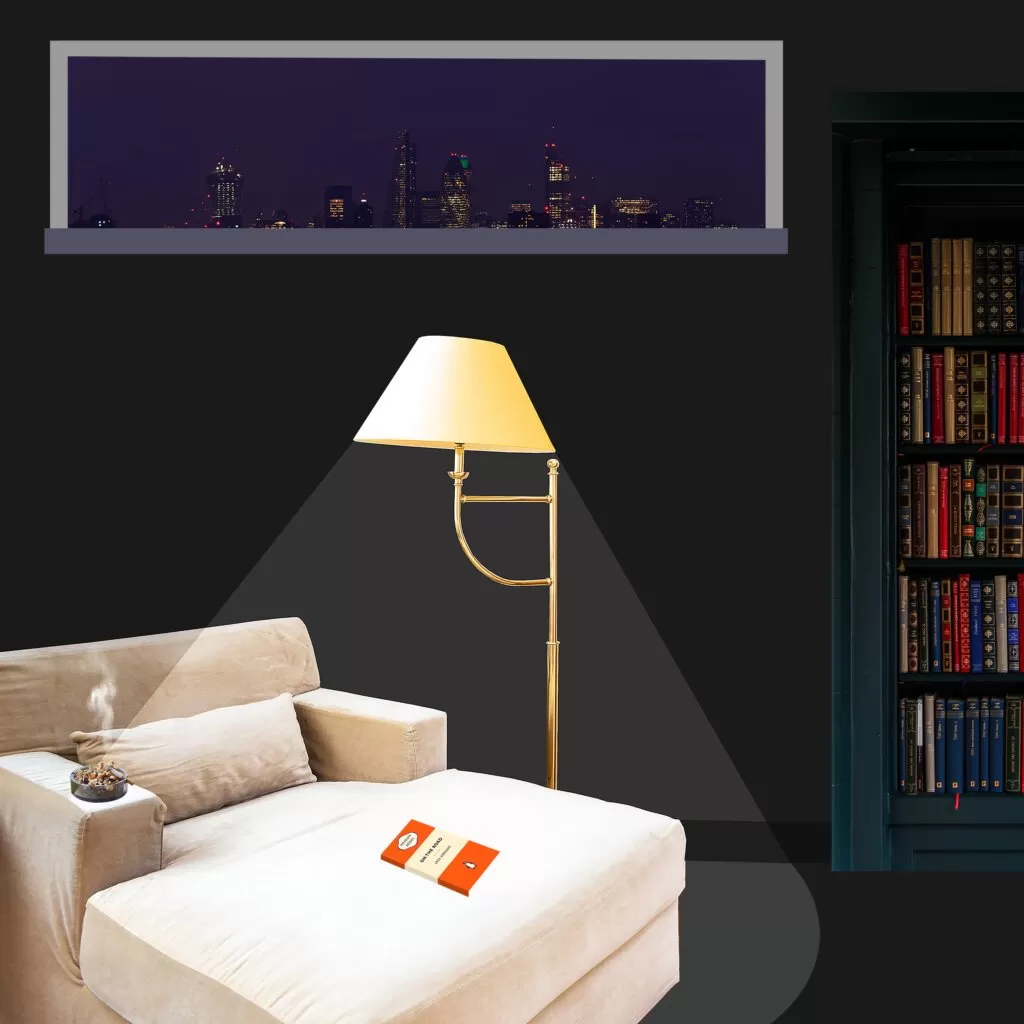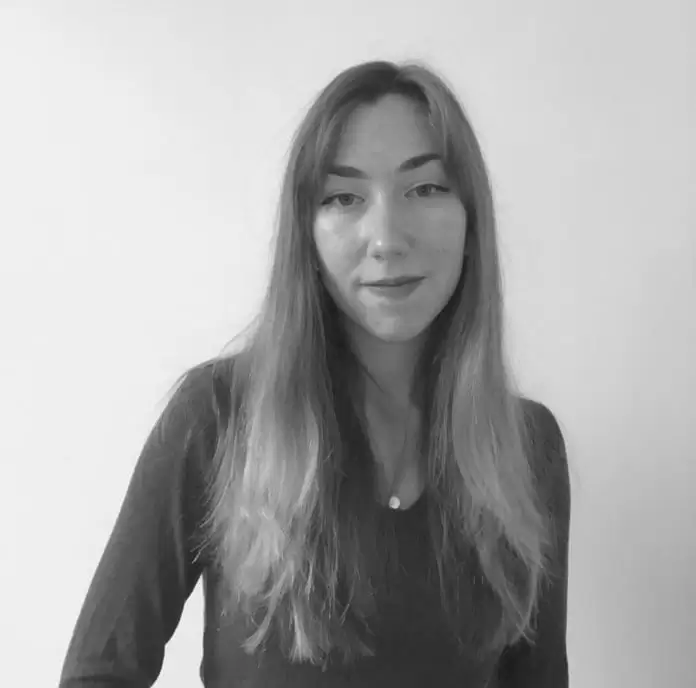Charlie Haydn Taylor recently exploded onto the British art scene out of nowhere. Taylor’s works have hung next to some of the biggest names in British art, lined the walls of numerous solo shows, and reached deep into viewer psyches across the country within a year. Fresh from a brief stint in the corporate world, Charlie Haydn Taylor’s work is unsurprisingly rife with observation and commentary on contemporary work and living habits.
The artist’s large scale graphic paintings of domestic interiors allude to consumerism, capitalism, and the people we become in private. His works are combinations of carefully selected digital collage and thoughtful washes of paint laid on by hand. Each work speaks to the current moment, something which can only be done by reference and comparison to the past.
In any Charlie Haydn Taylor work, you will find a blend of elements in patchwork scenes drawing from history, pop culture, and design. Taylor has just come off a series of successful solo shows and is now allowing this practice to evolve and become more introspective while further investigating the psychology of isolation and loneliness in the present day.
There is much to explore in Charlie Haydn Taylor’s world. Speaking to Artplugged exclusively, the artist breaks down his process and subject as well as an upcoming curatorial debut and first-time public art endeavour. It won’t be easy to miss the progression of Charlie Haydn Taylor’s practice, but if the current rate of the artist’s growth keeps hold, it will happen extraordinarily fast.
Q: To give Art Plugged readers some background on your work, could you talk about yourself a little bit and how you got to this point in your practice?
CHT: Yeah. I studied at Goldsmiths, but I actually studied design, not fine art. I think you can see a bit of that in the style of my work, but I always wanted to be an artist. The training I had in design and how I think about things like brands and consumerism all ties in together in my style. I worked as a graphic designer for a year after Goldsmiths, but it just wasn’t for me.
I recently went back to Jersey, where I’m originally from, because of the pandemic. There’s one very good gallery there ( Public/Private Gallery) that does lots of different shows and brings in some big names, which is brilliant for the island. I approached them with my portfolio, and they put me in a group show, which was titled The Best of British Art, and it had works by Tracey Emin, David Hockney, Julian Opie, some other big names. That caught the attention of other galleries, so that’s when this all kicked off, and I went full time. So it kind of just happened quite quickly, which was great.
Q: It’s only been a couple of years, and you’re doing so much. Could you tell the Art Plugged audience what your work is about what you’re doing as an artist?
CHT: I’m quite interested in the intimacy of our homes. But actually, it’s not so much the spaces themselves that I’m interested in. It’s more about the way people think. So it’s the idea of how we think away from the view of people in public, how we behave when we’re on our own. My new works do not include any figures.
I’m trying to make the viewer imagine that they’re in the space now. And I think the inclusion of consumer products, household products, literature, and all sorts of different things is a way of trying to give people an idea of who the people could be in these spaces. I think I’ve always found that people’s buying habits reflect their personality. You can almost understand someone just by what they buy, and I find that quite interesting. So, yeah, it’s a little bit about how people think.
SA: Turning towards a tall teal canvas with a thin white grid, Charlie describes his ideas at work on the visual plane?
CHT: Like this piece, for example, in a shower, was taken from the pop-cultural internet trend of sharing shower thoughts on Twitter. It’s like people’s deepest thoughts that they have while they’re in the shower. I find that an interesting relation to existentialism and philosophy. I think it’s because we’re on our own, locked in this room away from everyone naked and vulnerable, and you start having intense thoughts about the self. So it’s the idea of basically, to put it simply, just how we are away from others.
SA: You’ve previously mentioned that people sometimes assume that the paintings are mass-produced, which is interesting. Can you describe your painting process?
CHT: In terms of how I make the pieces, they are half digital and half painting. I quite like bridging traditional painting, which has been around for generations, to the digital alongside it, which is very new.
SA: How do you go about making and selecting these very specific and curated interiors and scenes? Are you working off of specific references?
CHT: I always come up with the idea of the piece first; that’s always my sort of primary drive when it comes to making the work. I do a lot of writing about what I’m going to be trying to say in the world.
Then I go about finding the kind of domestic space that I’m looking for, which means going through public domain sites and finding these images. The backgrounds are always the hyper-modern kind of environments, whereas the things I include don’t necessarily have to be hyper-modern. So I’ll think to myself about doing something related to showers and existentialism, so I go off and try and find a background that I think is visually nice enough to represent and make sense of that. A lot of my time is spent on my computer.
Reference-wise, I was always interested in collage artists from the 1960s like Richard Hamilton and Peter Blake. That’s kind of where it started in terms of the collage element. Because I’d done graphics, the way of making was always computerized rather than done with a hand scalpel cutter.
I’ve also always been drawn to the kind of clean cuts, really graphic looking painting style anyway. So when I merged the two, it seemed like a perfect option. I like the idea of it being or looking mass-produced but really only being a one-off painting. People will sometimes say, ‘Oh, could you do me another one of those?’ No, that’s not really how it works.
SA: I think your deliberate choices in cutting and pasting make these spaces feel as though things have been pulled away. They’re very reduced and diminished to the bare bones, which allows us to see the details more clearly
CHT: Like I was saying, I find the background images and work my way into the details. I’ve always enjoyed when people respond to my work because they spend a lot of time looking at the work and getting up close.
SA: This focus on the details also makes the work feel more psychological like we’re looking into private worlds. Does colour psychology play a significant role for you as well?
CHT: I guess I’ve created this world where these homes exist. They’re not technically real spaces that you’d find, but they almost exist in this separate universe that I’ve created. I usually play with colour and tonality and how you can change tones and colours to reflect night and day. Now, a lot more of the pieces have been one colour palette. I’ve been working in lights and darks to create atmospheric spaces.
People have asked me if I’ve ever worked with an interior designer. That’d be quite an interesting thing to do. I sort of have my style, which I could incorporate into creating someone’s home. But then again, it’s such a personal thing. It’s a real reflection of who we are, how we behave, and how we think.
SA: I want to talk about psychology, loneliness, and isolation a bit. What’s inspired the use of these themes?
CHT: Moving back to London. I love London, but it can feel so isolating. Whenever I go back to Jersey, I have a small close group of friends who get on so well and live nearby each other. In London, it’s the complete opposite. But there are positives and negatives about it. I spent a lot of time working on my own in the studio. I think that’s impacted how I’ve created the new work for sure.
I just did a piece that has the book On The Road by Jack Kerouac in it, and it’s pretty dark in terms of the way I’ve painted it, using black to create that kind of darker atmosphere in the evening. Having references like that allows me to delve into a more profound way of thinking and how people might be thinking.
I’m immensely enjoying playing with cultural references. I might be playing around with TV screens, maybe showing the news playing or something to hint at some cultural or social things going on. In my older finished work, I was looking at daily routines. So I was depicting life with a nine to five job, and the idea was to remind us of our mortality.
SA: What other projects do have coming up?
CHT: I’m curating a show for the end of July. It’s a group show of six artists, and it’s titled No Place Like Home. All the artists work with domestic spaces, the intimacy of different rooms, and how people think about space and home. I’ve done shows of my work and curated that, but this is an entirely different thing. Going a bit more in-depth on other people’s work for a change is nice.
Next year, I’ve also got my first public piece of art going up in Jersey. It’s like a huge scale sculptural work on the side of the building. It’s completely different to what I’ve done. It’s still in the sphere of style of my work, but it’s more figurative. I can’t say too much about what it’s going to look like, but it will be quite a large scale in the capital of Jersey, high up on a building so everyone can see, which is quite exciting.
https://www.instagram.com/charliehtart/
©2022 Charlie Haydn Taylor


